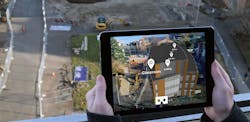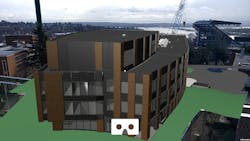Mortenson develops AR app for community engagement during construction of UW computer science building
Mortenson Construction has been in the vanguard of AEC firms using virtual reality as a tool for designing and building.
As far back as 2000, Mortenson’s Seattle office leaned on virtual design and construction modeling for the Frank Gehry-designed Walt Disney Concert Hall in Los Angeles.
More recently, the firm applied a technology it developed called Computerized Automatic Virtual Environment—CAVE for short—that, in 2013, helped the Building Team on the Pegula Ice Arena at Penn State University identify changes during the design stage, thereby averting $475,000 in costs. VR also helped shave $1.7 million in costs from the construction of the new Atlanta Braves stadium.
For the past 18 months, the firm's Immersive Technology group has been exploring possible construction-related opportunities for augmented reality (AR). Last year, Mortenson was among the first companies to partner with Daqri to test the application of its augmented reality-smart work helmet for construction jobsites. And in March, Mortenson went live with what it’s claiming is a first-of-its-kind AR mobile app that allows users to “see” what the second building of the Paul G. Allen Center for Computer Sciences and Engineering at the University of Washington in Seattle will look like, many months before its scheduled completion in January 2019.
Last January, the university’s Board of Regents authorized the start of construction for the 135,000-sf second building, which will be a much-needed addition to the Center where, since its first building opened in 2003, has seen its undergraduate and graduate computer science and engineering students increase by 50%, as has its faculty. UW reports that it currently has room for only 40% of the students who satisfy prerequisites and apply for computer science or computer engineering majors.
Mortenson was involved in the construction of the Center’s first building.
The AR app was developed to create excitement around this 135,000-sf building, which UW needs desperately to accommodate what has been a significant increase in students who want to major in computer science and engineering. Image: Mortenson Construction
Marc Kinsman, Mortenson’s Immersive Technology Developer, led the in-house team that developed the app. He says its purpose is to generate excitement about this project among the University of Washington community during construction. (He notes that the university removed a popular thoroughfare to “squeeze in” the new building, and anticipated some blowback from students and faculty.) The new AR mobile app, which is available for download onto iPhone and Android devices, lets users point their smartphones at the construction site on campus, or at a printed handout, to see a digital representation of the future building. Users can experience the exterior via AR, and then use VR to delve deeper into the building’s main lobby, workroom, robotics lab, and offices.
This building will include a 250-person lecture hall, seminar rooms, and conference facilities, as well as classrooms, lab space, and workrooms for faculty, students, and researchers.
“This window presents a tremendous opportunity to engage the public,” says Kinsman, who adds that VR and AR are “vast improvements” over traditional public engagement methods such as flyers, signage, or even websites. So far, the number of downloads has been modest, but Kinsman attributes that to a lack of marketing in the initial rollout.
That being said, this project has already attracted considerable attention. Its $105 million price tag will be funded by public and private sources that include Microsoft ($20 million), the state of Washington ($32.5 million), the University of Washington ($9 million), Amazon and Google ($10 million each), and Zillow ($5 million).
Kinsman says that Mortenson is planning to make available the AR app for future projects that include corporate campuses in Seattle and Portland, Ore.

